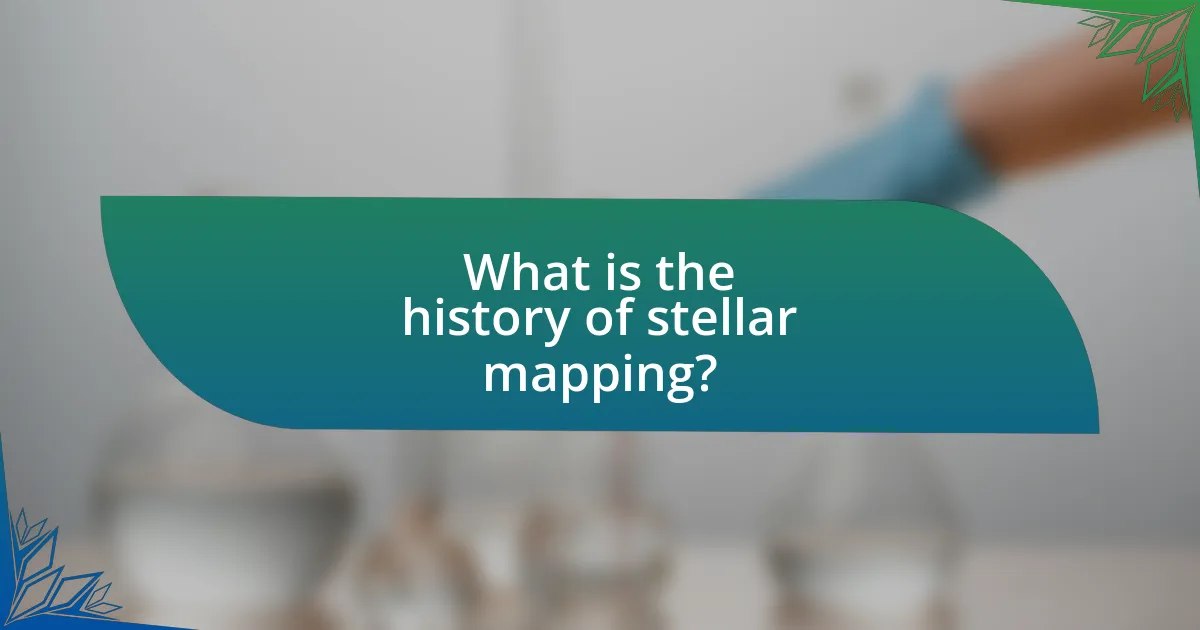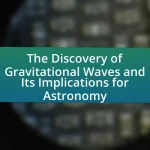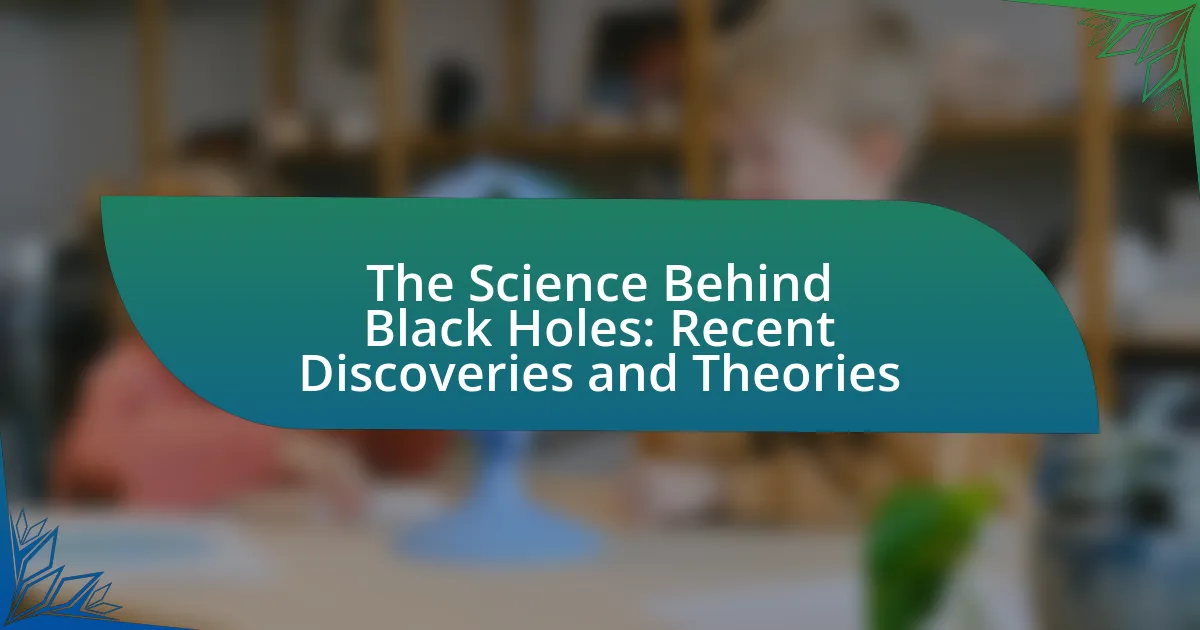The article examines the history of stellar mapping, tracing its evolution from ancient civilizations to modern astronomy. It highlights the contributions of early astronomers, such as the Babylonians and Greeks, who developed foundational star catalogs and observational techniques. The article discusses significant advancements during the Islamic Golden Age, the Renaissance, and the impact of technological innovations like the telescope and photography. It also covers the role of modern techniques, including astrometry and spectroscopy, and the influence of space exploration and artificial intelligence on contemporary stellar mapping practices. Key milestones in the development of astronomy and future trends in the field are also addressed.

What is the history of stellar mapping?
The history of stellar mapping dates back to ancient civilizations, where early astronomers created star catalogs based on observations of the night sky. The Babylonians, around 2000 BCE, were among the first to document celestial bodies, developing a system of constellations. Greek astronomer Hipparchus, in the 2nd century BCE, further advanced stellar mapping by compiling a comprehensive star catalog that included over 850 stars, establishing a coordinate system for celestial navigation.
During the Islamic Golden Age, astronomers like Al-Sufi and Al-Battani refined these maps, adding new stars and improving accuracy. The invention of the telescope in the 17th century by Galileo marked a significant leap, allowing for more detailed observations and the discovery of previously unseen stars and celestial phenomena.
In the 19th century, the advent of photography revolutionized stellar mapping, enabling astronomers to capture images of the night sky and create more precise star charts. The 20th century saw the development of modern astrometry, with the establishment of the Hipparcos satellite mission in the 1990s, which provided highly accurate measurements of star positions and distances, further enhancing our understanding of the cosmos.
How did ancient civilizations contribute to stellar mapping?
Ancient civilizations significantly contributed to stellar mapping by developing early astronomical systems that cataloged stars and constellations. For instance, the Babylonians created detailed star catalogs around 1000 BCE, which included observations of celestial bodies and their movements. Similarly, the ancient Greeks, particularly Hipparchus in the 2nd century BCE, compiled a star catalog that classified over 850 stars based on their brightness and position. The Egyptians also contributed by aligning their pyramids with specific stars, indicating their understanding of celestial navigation. These early efforts laid the groundwork for modern astronomy by establishing methods for observing and recording the night sky.
What methods did ancient cultures use to observe the stars?
Ancient cultures used various methods to observe the stars, including naked-eye observation, the construction of observatories, and the development of star catalogs. Naked-eye observation allowed civilizations such as the Babylonians and Egyptians to track celestial movements and create calendars based on the stars’ positions. They built structures like Stonehenge and the Pyramids of Giza, which aligned with specific celestial events, demonstrating their understanding of astronomy. Additionally, the Babylonians compiled extensive star catalogs, documenting constellations and celestial phenomena, which laid the groundwork for future astronomical studies.
Which ancient civilizations were most influential in early stellar mapping?
The ancient civilizations most influential in early stellar mapping were the Babylonians, Greeks, and Chinese. The Babylonians developed one of the earliest known star catalogs around 1000 BCE, documenting constellations and celestial events. The Greeks, particularly through figures like Hipparchus and Ptolemy, advanced stellar mapping techniques and created comprehensive star catalogs in the 2nd century CE, which influenced later astronomical studies. The Chinese contributed significantly with their meticulous records of celestial phenomena, including supernovae and comets, dating back to the Shang Dynasty (1600-1046 BCE). These civilizations laid the foundational knowledge for modern astronomy through their systematic observations and documentation of the night sky.
What advancements occurred during the Middle Ages in stellar mapping?
During the Middle Ages, significant advancements in stellar mapping included the development of more accurate star catalogs and the introduction of the astrolabe as a navigational tool. Notably, astronomers like Al-Battani and Al-Sufi compiled extensive star catalogs that improved upon earlier Greek works, documenting the positions and brightness of stars with greater precision. Al-Sufi’s “Book of Fixed Stars,” for example, included detailed descriptions and illustrations of constellations, which enhanced the understanding of stellar positions. Additionally, the translation of Greek astronomical texts into Latin during the 12th century facilitated the dissemination of knowledge, leading to improved techniques in celestial navigation and mapping. These advancements laid the groundwork for later developments in astronomy during the Renaissance.
How did Islamic scholars enhance the knowledge of stars?
Islamic scholars enhanced the knowledge of stars through meticulous observations, the development of astronomical instruments, and the translation and preservation of ancient texts. They established observatories, such as the one in Baghdad, where they conducted systematic star cataloging and refined existing models of celestial movements. Notably, scholars like Al-Battani improved the accuracy of star positions and contributed to trigonometric methods that facilitated better calculations of celestial phenomena. Their work laid the groundwork for later advancements in astronomy, influencing both the European Renaissance and modern astronomical practices.
What tools were developed during this period for stellar observation?
During this period, significant tools developed for stellar observation included the astrolabe, the telescope, and the sextant. The astrolabe, used by ancient astronomers, allowed for the measurement of celestial bodies’ positions and was crucial for navigation and timekeeping. The invention of the telescope in the early 17th century by figures like Galileo revolutionized astronomy by enabling detailed observation of celestial objects, such as the moons of Jupiter and the phases of Venus. The sextant, developed in the 18th century, improved navigational accuracy by allowing sailors to measure the angle between a celestial object and the horizon, further enhancing the understanding of stellar positions. These tools collectively advanced the field of astronomy and contributed to the mapping of the stars.
What role did the Renaissance play in the evolution of stellar mapping?
The Renaissance significantly advanced stellar mapping by fostering a revival of scientific inquiry and the application of observational techniques. During this period, astronomers like Nicolaus Copernicus and Tycho Brahe challenged existing geocentric models and emphasized the importance of empirical data. Copernicus’ heliocentric theory, presented in “De revolutionibus orbium coelestium” in 1543, shifted the focus of stellar mapping from Earth-centered perspectives to a more accurate representation of celestial bodies. Tycho Brahe’s meticulous observations in the late 16th century, recorded in his star catalog, provided a foundation for future astronomers, including Johannes Kepler, who later formulated laws of planetary motion based on Brahe’s data. This emphasis on observation and mathematical precision during the Renaissance laid the groundwork for modern astronomy and the evolution of stellar mapping techniques.
How did the invention of the telescope change stellar mapping?
The invention of the telescope revolutionized stellar mapping by allowing astronomers to observe celestial objects in greater detail and at greater distances than ever before. Prior to the telescope, stellar mapping relied on the naked eye, which limited the accuracy and scope of observations. With the introduction of the telescope in the early 17th century, astronomers like Galileo Galilei were able to discover previously unseen stars, moons, and planetary details, significantly expanding the known universe. This advancement led to more precise star catalogs and the ability to identify and classify celestial bodies based on their characteristics, fundamentally transforming the field of astronomy and enhancing our understanding of the cosmos.
Who were the key figures in Renaissance astronomy?
The key figures in Renaissance astronomy include Nicolaus Copernicus, Johannes Kepler, and Galileo Galilei. Nicolaus Copernicus proposed the heliocentric model of the solar system in his work “De revolutionibus orbium coelestium,” which fundamentally changed the understanding of the cosmos. Johannes Kepler formulated the laws of planetary motion, providing mathematical support for Copernicus’s theories, particularly in his works “Astronomia Nova” and “Harmonices Mundi.” Galileo Galilei made significant astronomical observations using a telescope, including the discovery of Jupiter’s moons and the phases of Venus, which provided empirical evidence for the heliocentric model. These contributions collectively advanced the field of astronomy during the Renaissance, marking a pivotal shift from geocentric to heliocentric perspectives.

What are the major milestones in the development of modern astronomy?
The major milestones in the development of modern astronomy include the heliocentric model proposed by Nicolaus Copernicus in the 16th century, the use of the telescope by Galileo Galilei in the early 17th century, Johannes Kepler’s laws of planetary motion published in 1609 and 1619, Isaac Newton’s formulation of the law of universal gravitation in 1687, and the establishment of the electromagnetic spectrum by James Clerk Maxwell in the 19th century. Each of these milestones significantly advanced the understanding of celestial mechanics and the nature of light, laying the groundwork for contemporary astronomical research. For instance, Copernicus’s model shifted the perspective from an Earth-centered universe to one where the Earth orbits the Sun, fundamentally changing the course of astronomy.
How did the 18th and 19th centuries shape our understanding of the universe?
The 18th and 19th centuries significantly advanced our understanding of the universe through the development of modern astronomy and the establishment of scientific methodologies. During this period, astronomers like William Herschel discovered Uranus in 1781, expanding the known solar system and challenging existing celestial models. The introduction of the telescope allowed for more detailed observations, leading to the cataloging of stars and nebulae, exemplified by the work of astronomers such as Johann Bayer and his star atlas, Uranometria, published in 1603, which laid the groundwork for future stellar mapping. Furthermore, the formulation of Newtonian physics provided a framework for understanding gravitational forces, influencing how celestial bodies were perceived and studied. The establishment of observatories and the use of precise instruments, such as the meridian circle, enabled more accurate measurements of celestial positions, culminating in the creation of star catalogs that are still referenced today. These advancements collectively transformed humanity’s perception of its place in the cosmos and laid the foundation for modern astrophysics.
What discoveries were made regarding star classification during this time?
During this time, significant discoveries in star classification included the development of the Harvard Classification Scheme, which categorized stars based on their temperatures and spectral characteristics. This system, established in the early 20th century by astronomers such as Annie Jump Cannon, classified stars into spectral types O, B, A, F, G, K, and M, reflecting their surface temperatures and colors. The classification system was validated through the analysis of stellar spectra, which revealed the presence of various elements and ionization states, thus providing a systematic approach to understanding stellar properties and evolution.
How did advancements in technology impact stellar mapping?
Advancements in technology significantly enhanced stellar mapping by enabling more precise measurements and observations of celestial bodies. The invention of the telescope in the early 17th century allowed astronomers like Galileo to observe stars and planets in greater detail, leading to more accurate star catalogs. Furthermore, the development of spectroscopy in the 19th century provided insights into the composition and distance of stars, refining stellar classification systems. The advent of digital imaging and computer algorithms in the late 20th century revolutionized data collection and analysis, allowing for the creation of comprehensive star maps that include millions of celestial objects, as seen in projects like the Sloan Digital Sky Survey. These technological advancements collectively transformed stellar mapping from rudimentary observations to a sophisticated science grounded in precise data and analysis.
What is the significance of the 20th century in stellar mapping?
The significance of the 20th century in stellar mapping lies in the development of advanced technologies and methodologies that revolutionized the field. During this period, the introduction of photographic plates and electronic detectors allowed astronomers to capture and catalog millions of stars with unprecedented accuracy. For instance, the Harvard College Observatory’s photographic survey, initiated in the early 1900s, resulted in the creation of the Henry Draper Catalogue, which classified over 225,000 stars by their spectra. Additionally, the establishment of the Hipparcos satellite in 1989 provided precise measurements of stellar positions and distances, enhancing our understanding of the Milky Way and stellar dynamics. These advancements marked a transition from manual observations to data-driven astronomy, fundamentally transforming stellar mapping practices.
How did space exploration influence our knowledge of stars?
Space exploration significantly enhanced our understanding of stars by providing direct observational data and advanced technologies for studying celestial phenomena. Missions such as the Hubble Space Telescope have allowed astronomers to capture high-resolution images of distant stars, revealing details about their composition, temperature, and life cycles. Additionally, space probes like the Kepler spacecraft have contributed to the discovery of exoplanets, expanding our knowledge of star systems and their potential for hosting life. These advancements have been crucial in refining models of stellar evolution and improving our understanding of the universe’s structure, as evidenced by the detailed mapping of star distributions and the identification of various stellar types.
What role did computer technology play in modern stellar mapping?
Computer technology has revolutionized modern stellar mapping by enabling precise data collection, analysis, and visualization of celestial objects. Advanced software and algorithms allow astronomers to process vast amounts of astronomical data from telescopes and satellites, leading to more accurate star catalogs and 3D models of the universe. For instance, the use of computer simulations has facilitated the mapping of the Milky Way galaxy, revealing its structure and dynamics with unprecedented detail. Additionally, technologies such as machine learning are employed to identify and classify stars and other celestial phenomena, enhancing the efficiency and accuracy of stellar mapping efforts.

How does stellar mapping continue to evolve today?
Stellar mapping continues to evolve today through advancements in technology and data analysis techniques. Modern telescopes, such as the Hubble Space Telescope and the upcoming James Webb Space Telescope, provide unprecedented resolution and sensitivity, allowing astronomers to map celestial bodies with greater accuracy. Additionally, the use of artificial intelligence and machine learning algorithms enhances the ability to analyze vast amounts of astronomical data, leading to more detailed and comprehensive star catalogs. For instance, the Gaia mission, launched by the European Space Agency, has already measured the positions and motions of over a billion stars, significantly improving our understanding of the Milky Way’s structure and dynamics.
What modern techniques are used in stellar mapping?
Modern techniques used in stellar mapping include astrometry, photometry, and spectroscopy. Astrometry involves precise measurements of star positions and movements, enabling the creation of accurate star catalogs. Photometry measures the brightness of stars over time, which helps in understanding their properties and distances. Spectroscopy analyzes the light spectrum emitted by stars, providing insights into their composition, temperature, and motion. These techniques have been enhanced by advanced technologies such as space telescopes and automated data processing, significantly improving the accuracy and detail of stellar maps.
How do telescopes and satellites contribute to current stellar mapping efforts?
Telescopes and satellites significantly enhance current stellar mapping efforts by providing high-resolution images and precise data on celestial objects. Ground-based telescopes, such as the Very Large Telescope, utilize advanced optics to capture detailed images of stars and galaxies, while space-based satellites like the Hubble Space Telescope eliminate atmospheric interference, allowing for clearer observations. Additionally, satellites equipped with photometric and spectroscopic instruments, such as the Gaia spacecraft, measure the positions, distances, and motions of over a billion stars, contributing to a comprehensive three-dimensional map of the Milky Way. This data is crucial for understanding stellar evolution and the structure of our galaxy, as evidenced by Gaia’s release of its first data set in 2016, which included precise measurements of 1.14 billion stars.
What role does data analysis play in contemporary astronomy?
Data analysis plays a crucial role in contemporary astronomy by enabling the interpretation and understanding of vast amounts of astronomical data collected from various sources, such as telescopes and space missions. This analysis allows astronomers to identify celestial objects, understand their properties, and study cosmic phenomena. For instance, the Sloan Digital Sky Survey has cataloged over 500 million celestial objects, demonstrating how data analysis techniques, including machine learning and statistical methods, are essential for processing and extracting meaningful insights from such large datasets.
What future trends can we expect in stellar mapping?
Future trends in stellar mapping include the increased use of artificial intelligence and machine learning to analyze vast amounts of astronomical data, leading to more precise star catalogs and improved identification of celestial objects. The advent of next-generation telescopes, such as the James Webb Space Telescope, will enhance our ability to map distant galaxies and exoplanets, providing deeper insights into the structure of the universe. Additionally, advancements in 3D mapping techniques will allow astronomers to visualize the spatial distribution of stars and other celestial bodies more accurately. These trends are supported by ongoing research and technological developments in the field of astronomy, which emphasize the integration of computational methods and innovative observational tools.
How might artificial intelligence change the field of astronomy?
Artificial intelligence might revolutionize the field of astronomy by enhancing data analysis, automating the discovery of celestial objects, and improving predictive modeling. AI algorithms can process vast amounts of astronomical data from telescopes and satellites, identifying patterns and anomalies that human researchers may overlook. For instance, machine learning techniques have been successfully applied to classify galaxies and detect exoplanets, significantly accelerating the pace of discovery. A notable example is the use of AI in the analysis of data from the Kepler Space Telescope, where it helped identify thousands of potential exoplanets, demonstrating the effectiveness of AI in transforming astronomical research.
What are the potential implications of upcoming space missions on stellar mapping?
Upcoming space missions are likely to enhance stellar mapping by providing high-resolution data and improved observational capabilities. For instance, missions like the James Webb Space Telescope and the European Space Agency’s Gaia project are set to deliver unprecedented detail about star positions, distances, and compositions. Gaia, launched in 2013, has already mapped over a billion stars, significantly refining our understanding of the Milky Way’s structure. These advancements will enable astronomers to create more accurate three-dimensional maps of stellar distributions, leading to better insights into stellar evolution and galactic dynamics.
What practical tips can amateur astronomers use for stellar mapping?
Amateur astronomers can enhance their stellar mapping by utilizing star charts and mobile apps to identify constellations and celestial objects. Star charts provide a visual guide to the night sky, helping users locate stars and planets based on their geographical location and time of year. Mobile apps, such as SkySafari or Star Walk, offer real-time tracking and augmented reality features that simplify the identification process. Additionally, maintaining a consistent observation schedule allows amateur astronomers to track the movement of stars and planets over time, aiding in the accuracy of their maps. Using a red flashlight preserves night vision while taking notes or adjusting equipment, ensuring a more effective mapping experience.




